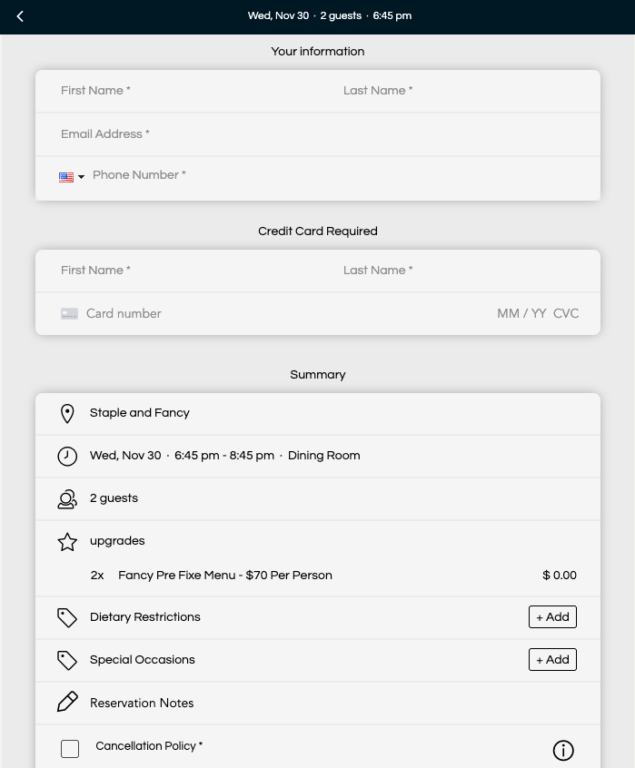Restaurant Email Marketing: How to Track and Measure Your ROI
Sevenrooms
5 min read
Nov 30, 2022

Sevenrooms
5 min read
Nov 30, 2022

Email marketing for restaurants, when done right, can be your most lucrative channel. In fact, we’ve seen restaurants generate as much as $400,000 in revenue in one year from emails alone.
Though it’s one of the oldest digital strategies, email still dominates when it comes to return on investment (ROI), generating on average, $36 for every dollar spent.
But for many restaurant marketers, proving email ROI can be challenging, especially if you’re collecting data from disparate systems across multiple venues. And while most email platforms provide basic metrics to measure performance, they often lack the end-to-end capability of tying your email campaigns back to revenue. This is likely because none of the most known platforms were purpose-built for restaurant operators.
In this article, we’ll break down the different types of metrics restaurant marketers should be tracking and provide actionable ways to help you prove and improve your contribution to the bottom line.
The rise of online booking and ordering due to the pandemic has changed the way consumers engage with restaurants.
There is now a higher expectation for personalized service and communication, and the savviest restaurants have started to catch on. But for the majority, there is still room for improvement.
According to Campaign Monitor’s 2022 Email Benchmarking Report, the restaurant industry has an average email open rate of 18.5%, the second lowest on the list. While open rate alone isn’t the only metric for measuring success, it’s one of the many factors that contribute to improving email marketing ROI.
FYI: At SevenRooms, our clients average a 70% open rate — more than triple the industry benchmark.
Email metrics like open and click-through rates help you understand how well your emails are performing, but how does that translate into dollars and new business?
In the end, it’s not open rates that matter to your boss: it’s the dollars those opens generate. The truth is email success is measured in both engagement and revenue, and you should be tracking both for every email that you send.
There are a handful of common, key metrics that give you insight into email marketing performance. They help you understand how your audience is engaging with our content which has a direct impact on ROI.
Email metrics give us directional feedback on how we can make changes that impact the bottom line. But looking at these metrics alone tells only half of the story.
The majority of email marketing platforms only provide engagement metrics. However, restaurants need to measure metrics tied directly to their business goals.
Tracking these metrics isn’t simple — to find them, you would need to connect data across different platforms, and that data might not be directly available
To know your email marketing is making a meaningful impact on your business, you first need to lay the foundation to be able to track ROI. It starts with collecting the right data and centralizing it in one place.

Learn More: The Ultimate Email Marketing Guide for Restaurants
Guest data fuels email marketing. Robust guest data ensures your email list will have high deliverability and also allow you to personalize communications.
While valid email addresses and contact information are table stakes, data such as location, dietary preferences, special occasion history, check average and visit frequency can take your campaigns to the next level. So how do you go about collecting rich guest data?
Your best opportunity to collect guest data is when they make a reservation or place an online order. Guests are used to providing information at this stage in the journey, and seeking out additional information such as allergies and special occasions sets you up for success down the line.

Staples and Fancy, located in Seattle, is one of Ethan Stowell Restaurants’ 18 locations. They customized their reservation widget using SevenRooms to collect detailed guest contact information, seating preferences, menu upgrade data, allergy and dining preferences as well as special occasions.
If you have a substantial walk-in business, set up a virtual waitlist. Guests can add themselves online via Google, your website and a QR code at your host stand. This is an often overlooked opportunity to collect valuable information that can help you better serve your guests during their visit and market to them later.
If you’re using different platforms for your reservations, online orders, POS, private events and email marketing, your data is unlikely to be consistent across systems. When systems don’t talk to each other, data reconciliation becomes tedious… if not impossible.
If this sounds familiar, it’s time to reevaluate your tech stack and find solutions that integrate with each other, or even better, an all-in-one solution.
For example, an integration between your reservation, online ordering and POS systems consolidates and enriches your guest data. Over time, as guests continue to dine-in or order takeout, you collect detailed behavior and preference information that helps you both provide personalized service and also targeted email marketing.
Pro Tip: Switching from third-party marketplaces to direct channels for reservations and online orders allows you to capture and own your guest data. Learn more about the benefits of direct channels and integrated tech stacks with SevenRooms.
Once you’ve built the foundation for tracking ROI, you can use data to test and improve your email campaigns.
While you could send an email to everyone in your database, the spray-and-pray approach has proven to be a thing of the past. Modern email marketing tools give you the power to segment and personalize email so that every message feels relevant.
Segment your audiences with groups of people with similar criteria, such as:
Separating out your communications so that they speak to each population is key to driving engagement. According to The Restaurant Times, personalized marketing efforts have been shown to increase return visits for full-service restaurants by 6-12% and quick-service restaurants by 8-20%.
Segmentation is essential for both large-scale communication, like announcements, and also smaller, one-to-one messaging.
Let’s face it: email marketing is a lot of work. For restaurant marketers who handle communication for multiple locations, personalization at scale is nearly impossible.
Marketing Automation empowers you to deliver timely, personalized messages to your guests with minimal effort, and the results speak for themselves.
The Altamarea Group used SevenRooms’ Marketing Automation to follow up after every reservation and online order as well as re-engage guests who hadn’t recently interacted with the restaurant… all through automated emails.
In 2021 alone, they sent automated emails to 47,000 people, generating $340,000 in reservation revenue and $60,000 in online ordering revenue. Each email earned Altamarea Group $7.43, nearly 6X the industry average. Read the full case study.
FYI: Learn more about how SevenRooms can help you generate incremental revenue with email marketing automation.
Send Trigger-Based, Timely Emails
These emails are highly targeted and personalized, dependent on guest behavior. They are intended to generate engagement and keep your venues top of mind. Because these emails are sent to each individual rather than a large, depersonalized batch, they tend to have higher open rates and generate greater ROI.
Automated emails can thank guests after their first visit, re-engage them when they haven’t visited in a while, and follow up on positive and negative feedback.
Example of a targeted guest email based on a guest’s visit history with an offer to incentivize another visit. Plain text emails are effective with this type of communication as it appears authentic and personalized from the GM.
Send Segmented, Hyper-targeted Email Campaigns
Build segmented email lists for targeted promotions by finding commonalities among your subscribers, from venues visited to items ordered, there are a million ways to segment your audience.
As we discussed earlier, enriched guest data allows you to find commonalities based on certain behaviors or preferences. Some example segmentation might be:
Pro Tip: If you email UK and EU recipients, you must comply with GDPR regulations. Certain types of emails require a subscriber’s consent with strict opt-in and opt-out requirements. Read more on GDPR compliance for email marketing
It can be overwhelming to choose the right email marketing platform for your restaurant. Many solutions cater to a variety of businesses, but few are built specifically for the hospitality industry.
Choose a provider that integrates with your current solutions, rather than one that becomes a challenge to manage. You should consider:
As a restaurant marketer, your time and resources are valuable. Tracking and proving your email ROI can help you prioritize the channels that have the greatest impact on business while making you look like a rockstar. SevenRooms’ all-in-one platform allows you to do all of the above and so much more. Book a demo to learn more.
According to Campaign Monitor, the average email marketing ROI is $36 for every $1 spent. However, your specific email ROI will depend on your industry, individual business, and email campaign goals.
Compared to other digital channels, email marketing still has the highest ROI.
Email marketing is undoubtedly one of the most effective channels for restaurants because of its high ROI.